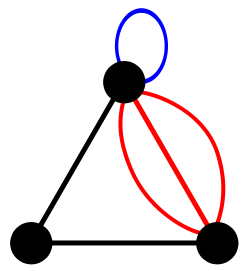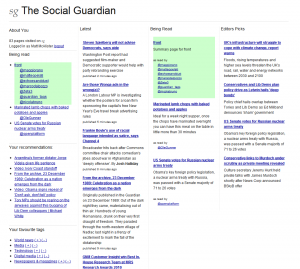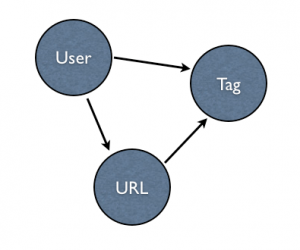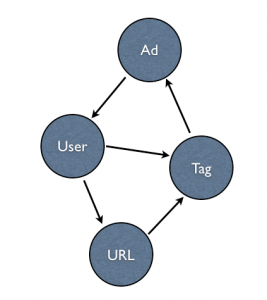Most media organizations measure success in terms of a cost model, a profit model, or a growth model. Â The key decisions are about either operating at peak efficiency, increasing revenue while decreasing cost, or acquiring more customers, respectively.
Actually, most media organizations operate along those three axes simultaneously and have one or two additional hooks that make them unique in their market.
However, there is another way to model success in the digital market.
If there’s one lesson to learn from the growth of social software it’s that value can be found in the relationships between people. Â The more relationships, the better. Â The more activity across those relationships, the better.
Social networks understand that there is value in each person in the network, but also, and perhaps more importantly, that there is value in the links between people, too.
They model success using graph theory.  A mathematical graph is “an abstract representation of a set of objects where some pairs of the objects are connected by links.”  This graph, for example, has 3 nodes and 6 edges: We’re all familiar with the Six Degrees of Kevin Bacon theory that any actor or actress can be linked through their film roles to Kevin Bacon within six steps.  This is a graph, too.
We’re all familiar with the Six Degrees of Kevin Bacon theory that any actor or actress can be linked through their film roles to Kevin Bacon within six steps.  This is a graph, too.
 What a media organisation needs to learn from this approach is which things need to be connected and how to fuel value in those relationships.
What a media organisation needs to learn from this approach is which things need to be connected and how to fuel value in those relationships.
Importantly, the graph must be self-reinforcing. Â In other words, nodes in the network must benefit from both the existence of new nodes and activity along the edges between them.
One of the projects developed at the Guardian in a recent ‘Super Happy Dev Day’ (aka hack day) demonstrated how powerful a simple self-reinforcing graph can be. Â It’s called The Social Guardian.
After logging on with your twitter account, The Social Guardian will show you a page with 3 columns of content and some navigation. Â It includes the editorially chosen featured articles from the Guardian home page, a most recent articles list, and a list of articles other users are reading right now. Â The left-hand column shows you who is reading the site simultaneously with you, recommended articles based on what you’ve read , and a profile of topics it thinks you like.
 The Social Guardian backend is a very simple database of users, urls, and tags. Â Each user, url and tag is a node in the graph. Â There’s a simple directed graph that could be visualized like this:
The Social Guardian backend is a very simple database of users, urls, and tags. Â Each user, url and tag is a node in the graph. Â There’s a simple directed graph that could be visualized like this:
If it also included each person’s social graph (all their friends and followers), then the recommendation capabilities could get even stronger.
Of course, you can then imagine a very powerful ad platform optimised not only against the profile of users but also against both the live activity happening on the site and behaviors extracted from connected and other similar users.
Advertising becomes incredibly powerful when a system is optimized to match activity against marketing messages. Â The unique characteristics of this particular application are the individuals’ profiles, the content they are looking at and the live nature of the experience.
Therefore, the appropriate ad platform would offer advertisers the ability to target messages to users based on what their profiles say about them and to be able to adjust the content of the messaging based on what content the users are viewing…and to do it right now.
Clearly, the graph in this kind of model gets complicated very quickly. Â These nodes each grow massively. Â The edges have different value, and there are multiple edges between nodes.
This is one of the many reasons that the concept of an Active User is so useful. Â It gives the system permission to throw out any data it deems irrelevant after 30 days or to abstract the last 30 days’ data into smaller data chunks.
But let’s be real here, these are only some of the nodes a media organization cares about, and none of them are very clean and easy to work with.
- We have different concepts of what a user is, and users appear in many different ways to the business.
- Content used to be associated with a single canonical URL, but the influx of very small pieces of data and data within datasets make the concept of content much more complicated.
- Ad campaigns can come in all different shapes, sizes and values with different intents and purposes.
- Distribution platforms and digital products have different user experiences with different rules of engagement.
- The different sources of content will have different usage models to them. Â One of those sources is the user.
Trying to take all that into account becomes an incredibly challenging graph problem.
However, there’s a beauty in such a design which is that the edges convey an action. Â And those actions are where success will be discovered.
Success in a graph-centered media model is one where you can clearly measure the impact of the edges. Â Rather than think about increasing the size of the nodes, think about increasing the activity in areas that encourage the nodes to grow.
As the saying goes, “If you look after the pennies, the pounds will look after themselves.”
For example, rather than think about how to acquire new users and build the total user number up, the graph helps you think about what activities are going to encourage more users to participate.
If the system works better for each individual when each individual brings their friends along into the system, then the network will do all the work of building the user numbers up for its own selfish gain.
In the Social Guardian example, the incentive to encourage more users to join is natural. Â You want other people to bubble up interesting content for you, and you might like to read it along with them. Your experience gets better with more users, therefore you want to add users to the system.
Everyone wins.
And that’s the lesson: generative networks build value for all those who participate.
It works in lots of different contexts, and the media business is incredibly well suited for it.
Of course, publishers with open approaches to the network have an easier path toward generativity, but it’s certainly not limited only to those with open platforms.
As Steven Berlin Johnson once noted about the amazing power of Apple’s more closed ecosystem:
“…if you get the conditions right, a walled garden can turn into a rain forest.”
The key is to build generativity in the business model, a business architecture that creates value for everyone as opposed to the more simplistic industrial era give-and-take relationship with customers. Â Value must form as a result of more participants contributing more activity.
More specifically, advertising must match and relate to the activity happening across the system. Â Products offered for sale must add a layer of value on top of what’s possible within the network. Â Partners using the system must be able to profit while also adding value the system can’t otherwise offer on its own.
Crucially, the business must be open to giving away control to the participants in the platform, or it risks failing to be generative.
Jonathan Zittrain argues in his book “The Future of the Internet and How to Stop It” that openness is a prerequisite to generativity. Â Owners of generative platforms need to understand the impact of what they are doing and to act responsibly for future generations.
“the pieces are in place for a wholesale shift away from the original chaotic design that has given rise to the modern information revolution. This counterrevolution would push mainstream users away from a generative Internet that fosters innovation and disruption, to an appliancized network that incorporates some of the most powerful features of today’s Internet while greatly limiting its innovative capacity—and, for better or worse, heightening its regulability. A seductive and more powerful generation of proprietary networks and information appliances is waiting for round two. If the problems associated with the Internet and PC are not addressed, a set of blunt solutions will likely be applied to solve the problems at the expense of much of what we love about today’s information ecosystem. (p. 8)”
via David Weinberger
This series is an attempt to assemble some ideas I’ve been exploring for a while. Â Most of it is new, and some of it is from previous blog posts and recent-ish presentations. I’ve split the document up into a series of posts on the blog here, but it can also be downloaded in full as a PDF or viewed as a sort of ebook via Scribd:

